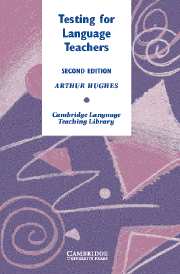Book contents
- Frontmatter
- Contents
- Acknowledgements
- Preface
- 1 Teaching and testing
- 2 Testing as problem solving: an overview of the book
- 3 Kinds of tests and testing
- 4 Validity
- 5 Reliability
- 6 Achieving beneficial backwash
- 7 Stages of test development
- 8 Common test techniques
- 9 Testing writing
- 10 Testing oral ability
- 11 Testing reading
- 12 Testing listening
- 13 Testing grammar and vocabulary
- 14 Testing overall ability
- 15 Tests for young learners
- 16 Test administration
- Appendix 1 The statistical analysis of test data
- Appendix 2 Item banking
- Appendix 3 Questions on the New Zealand youth hostels passage
- Bibliography
- Subject Index
- Author Index
- Frontmatter
- Contents
- Acknowledgements
- Preface
- 1 Teaching and testing
- 2 Testing as problem solving: an overview of the book
- 3 Kinds of tests and testing
- 4 Validity
- 5 Reliability
- 6 Achieving beneficial backwash
- 7 Stages of test development
- 8 Common test techniques
- 9 Testing writing
- 10 Testing oral ability
- 11 Testing reading
- 12 Testing listening
- 13 Testing grammar and vocabulary
- 14 Testing overall ability
- 15 Tests for young learners
- 16 Test administration
- Appendix 1 The statistical analysis of test data
- Appendix 2 Item banking
- Appendix 3 Questions on the New Zealand youth hostels passage
- Bibliography
- Subject Index
- Author Index
Summary
When appropriate statistical analysis of test results has been carried out, it is possible to construct what is called an item bank. An item bank is a large collection of previously trialled test items, normally stored nowadays on a computer, which is placed at the disposal of test constructors. Usually stored with each item in the bank are:
A number of identifying criteria, relating to such things as its content, class level, stage in the syllabus or course book, the testing technique used, and number of points.
Correct response(s) and scoring instructions.
Measurement information on the item, such as difficulty level and discrimination index, which has been obtained through previous trialling.
Notes on the item (when written, when used, etc.).
Once they have access to an item bank, test constructors simply choose from it the items that they need for a test. They do this by entering into the computer details of the kinds of items they need. They might begin for example, by asking for receptive vocabulary items which have a facility value between 0.4 and 0.6, and which relate to third year study at their institution. The computer will immediately present them with all the items in the bank that meet these criteria, and they are given the opportunity to ‘browse’ through these, choosing those items that they decide to include in the test.
Information
- Type
- Chapter
- Information
- Testing for Language Teachers , pp. 234 - 235Publisher: Cambridge University PressPrint publication year: 2002
